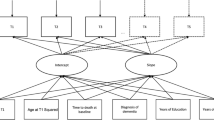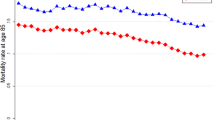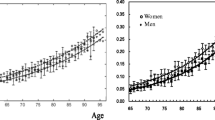Abstract
Multistate life tables are used to estimate life expected in three frailty states: frailty free, mild/moderate frailty, severe frailty. Estimates are provided for the combination of education and wealth by age, stratified by sex. Data consider 17,115 cases from the Health and Retirement Study, 2000–2014. Frailty is measured using a 59 item frailty index based on deficit accumulation. Estimates are derived using stochastic population analysis for complex events. Population-based and status-based results are reported. Findings confirm a hypothesis that the combination of higher education and wealth results in longer lives in more favorable degrees of frailty. Also, as hypothesized, wealth generally affords a greater advantage than does education among those with severe frailty at baseline. For instance, high wealth provides a 70-year-old woman with severe frailty at baseline 0.70 more total years and 0.81 more frailty free years then her counterpart with low wealth, compared to gains of 0.39 and 0.54, respectively, for those with high education. Unexpectedly, wealth also has a greater role among those frailty free at baseline. A 70-year-old woman frailty free at baseline with high wealth lives 3.19 more net years and 4.13 more years frailty free than her counterpart with low wealth, while the same comparison for high versus low education indicates advantages of 2.00 total and 1.96 frailty free years. Relative change ratios also indicate more robust results for wealth versus education. In sum, there is evidence that inequality in duration of life in degrees of frailty is socially patterned.

Similar content being viewed by others
Availability of data and material
https://hrs.isr.umich.edu/data-products/access-to-public-data.
Code availability
Contact lead author.
References
Andrew MK, Mitnitski AB, Rockwood K (2008) Social vulnerability, frailty and mortality in elderly people. PLoS ONE 3:e2232
Berthelot J-M, Mayer F, Wilkins R, Ross N (2002) Disability-free life expectancy by health region. Health Rep 13:49
Brothers TD, Theou O, Rockwood K (2014) Frailty and migration in middle-aged and older Europeans. Arch Gerontol Geriatr 58:63–68
Bugliari D et al (2019) RAND HRS detialed impulations file 2016 (V1) documentation. RAND Center for the Study of Aging, Santa Monica
Bureau of Labor Staistics (2014) Consumer Price Index—June 2014. U.S. Department of Labor, Washington
Butler A et al (2016) Frailty: a costly phenomenon in caring for elders with cognitive impairment. Int J Geriatr Psychiatry 31:161–168
Cai L, Hayward MD, Saito Y, Lubitz J, Hagedorn A, Crimmins E (2010) Estimation of multi-state life table functions and their variability from complex survey data using the SPACE Program. Demogr Res 22:129
Cambois E, Robine J-M, Hayward MD (2001) Social inequalities in disability-free life expectancy in the French male population, 1980–1991. Demography 38:513–524
Casale-Martinez RI, Navarrete-Reyes AP, Avila-Funes JA (2012) Social determinants of frailty in elderly Mexican community-dwelling adults. J Am Geriatr Soc 60:800–802
Chiu C-T (2018) The SPACE program. UT Blogs. The University of Texas, Austin
Chiu C-T, Yong V, Chen H-W, Saito Y (2019) Disabled life expectancy with and without stroke: a 10-year Japanese prospective cohort study. Qual Life Res 28:3055–3064
Chris White GE (2010) Inequalities in disability-free life expectancy by social class and area type: England, 2001–2003. Health Stat Q 45:57–80
Clegg A, Young J, Iliffe S, Olde Rikkert M, Rockwood K (2013) Frailty in elderly people. The Lancet 381:752–762
Clegg A et al (2016) Development and validation of an electronic frailty index using routine primary care electronic health record data. Age Ageing 45:353–360
Crimmins EM, Zhang Y, Saito Y (2016) Trends over 4 decades in disability-free life expectancy in the United States. Am J Public Health 106:1287–1293
Crocker TF, Brown L, Clegg A, Farley K, Franklin M, Simpkins S, Young J (2019) Quality of life is substantially worse for community-dwelling older people living with frailty: systematic review and meta-analysis. Qual Life Res 28:1–16
Dent E, Kowal P, Hoogendijk EO (2016) Frailty measurement in research and clinical practice: a review. Eur J Intern Med 31:3–10
Fried LP et al (2001) Frailty in older adults: evidence for a phenotype. J Gerontol Ser A Biol Sci Med Sci 56:M146–M157
Fulop T, Larbi A, Witkowski JM, McElhaney J, Loeb M, Mitnitski A, Pawelec G (2010) Aging, frailty and age-related diseases. Biogerontology 11:547–563
Gobbens RJ, Luijkx KG, Wijnen-Sponselee MT, Schols JM (2010a) search of an integral conceptual definition of frailty: opinions of experts. J Am Med Dir Assoc 11:338–343
Gobbens RJ, van Assen MA, Luijkx KG, Wijnen-Sponselee MT, Schols JM (2010b) Determinants of frailty. J Am Med Dir Assoc 11:356–364
Guralnik JM, Alecxih L, Branch LG, Wiener JM (2002) Medical and long-term care costs when older persons become more dependent. Am J Public Health 92:1244–1245
Hajek A et al (2018) Frailty and healthcare costs—longitudinal results of a prospective cohort study. Age Ageing 47:233–241
Health and Retirement Study (2015a) Health and retirement study, data description University of Michigan. Accessed onlin April 9, 2015 at http://hrsonline.isr.umich.edu/modules/meta/tracker/desc/trk2012.pdf
Health and Retirement Study (2015b) Health and retirement study: a longitudinal study of health, retirement, and aging sponsored by the National Institute on Aging University of Michigan. Accessed online April 13, 2015 at http://hrsonline.isr.umich.edu
Herd P, Goesling B, House JS (2007) Socioeconomic position and health: the differential effects of education versus income on the onset versus progression of health problems. J Health Soc Behav 48:223–238
Herr M, Arvieu J-J, Ankri J, Robine J-M (2018) What is the duration of life expectancy in the state of frailty? Estim SIPAF Study Eur J Ageing 15:165–173
Jürschik P, Nunin C, Botigué T, Escobar MA, Lavedán A, Viladrosa M (2012) Prevalence of frailty and factors associated with frailty in the elderly population of Lleida, Spain: the FRALLE survey. Arch Gerontol Geriatr 55:625–631
Kulminski AM, Ukraintseva SV, Kulminskaya IV, Arbeev KG, Land K, Yashin AI (2008) Cumulative deficits better characterize susceptibility to death in elderly people than phenotypic frailty: lessons from the Cardiovascular Health Study. J Am Geriatr Soc 56:898–903
Mathers CD (2002) Health expectancies: An overview and critical appraisal. In: Murray CJL, Salomon JA, Mathers CD, Lopez AD (eds) Summary measures of population health: concepts, ethics, measurement and applications. World Health Organization, Geneva, pp 177–204
Minicuci N et al (2004) Disability-free life expectancy: a cross-national comparison of six longitudinal studies on aging. CLESA Project Eur J Ageing 1:37–44
Mitnitski A, Mogilner AJ, Rockwood K (2001) Accumulation of deficits as a proxy measure of aging. Sci World J 1:323–336
Mitnitski A, Song X, Rockwood K (2007) Improvement and decline in health status from late middle age: modeling age-related changes in deficit accumulation. Exp Gerontol 42:1109–1115
Pantoja P et al (2016) RAND HRS income and wealth imputations, Version P. RAND Center for the Study of Aging, Labor & Population Program
Robine J-M, Jagger C, Romieu I (2001) Disability-free life expectancies in the European Union countries: calculation and comparisons. Genus 42:89–101
Rockwood K (2005) What would make a definition of frailty successful? Age Ageing 34:432–434
Rockwood K, Howlett SE (2019) Age-related deficit accumulation and the diseases of ageing. Mech Ageing Dev 180:107–116
Rockwood K, Mitnitski A (2007) Frailty in relation to the accumulation of deficits. J Gerontol Med Sci 62:722–727
Rockwood K, Mitnitski A (2011) Frailty defined by deficit accumulation and geriatric medicine defined by frailty. Clin Geriatr Med 27:17–26
Rogers RG, Rogers A, Belanger A (1992) Disability-free life among the elderly in the United States: sociodemographic correlates of functional health. J Aging Health 4:19–42
Romero-Ortuno R (2013) An alternative method for Frailty Index cut-off points to define frailty categories. Eur Geriatr Med 4:299–303
Romero-Ortuno R, Fouweather T, Jagger C (2013) Cross-national disparities in sex differences in life expectancy with and without frailty. Age Ageing 43:222–228
Rowland DT (2009) Global population aging: history and prospects. In: Uhlenberg P (ed) International handbook of population aging. Springer, Berlin, pp 37–65
Saito Y, Qiao X, Jitapunkul S (2003) Health expectancy in Asian countries. In: Robine J-M, Jagger C, Mathers CD, Crimmins EM, Suzman RM (eds) Determining health expectancies. Wiley, Hoboken, pp 289–318
Saito Y, Robine J-M, Crimmins EM (2014) The methods and materials of health expectancy. Stat J Int Assoc Off Stat 30:209–223
Salinas-Rodríguez A, Manrique-Espinoza B, Heredia-Pi I, Rivera-Almaraz A, Ávila-Funes JA (2019) Healthcare costs of frailty: implications for long-term care. J Am Med Dir Assoc 20:102–103
Solé-Auró A, Beltrán-Sánchez H, Crimmins EM (2015) Are differences in disability-free life expectancy by gender, race, and education widening at older ages? Popul Res Policy Rev 34:1–18
Szanton SL, Seplaki CL, Thorpe RJJ, Allen JK, Fried LP (2010) Socioeconomic status is associated with frailty: the Women’s Health and Aging Studies. J Epidemiol Commun Health 64:63–67
Tareque MI, Chan A, Saito Y, Ma S, Malhotra R (2019) The impact of self-reported vision and hearing impairment on health expectancy. J Am Geriatr Soc 67:2528–2536
Theou O, Brothers TD, Rockwood MR, Haardt D, Mitnitski A, Rockwood K (2013) Exploring the relationship between national economic indicators and relative fitness and frailty in middle-aged and older Europeans. Age Ageing 42:614–619
Wohland P, Rees P, Gillies C, Alvanides S, Matthews FE, O’Neill V, Jagger C (2014) Drivers of inequality in disability-free expectancy at birth and age 85 across space and time in Great Britain. J Epidemiol Commun Health 68:826–833
Woo J, Goggins W, Sham A, Ho S (2005) Social determinants of frailty. Gerontology 51:402–408
Zimmer Z, House JS (2003) Education, income and functional limitation transitions among American adults: contrasting onset and progression. Int J Epidemiol 32:1089–1097
Zimmer Z, Hidajat M, Saito Y (2015) Changes in total and disability-free life ex-pectancy among older adults in China: do they portend a compression of morbidity? Int J Popul Stud 1:4–18
Acknowledgements
The lead author acknowledges funding from the Social Sciences and Humanities Research Council of Canada and their Canada Research Chairs program.
Funding
The lead author acknowledges funding from the Social Sciences and Humanities Research Council of Canada and their Canada Research Chairs program. The Health and Retirement Study receives funding from United States Department of Health and Human Services. National Institutes of Health. National Institute on Aging (NIA U01AG009740), United States Social Security Administration.
Author information
Authors and Affiliations
Contributions
ZZ conceptualized the paper, conducted the analysis and wrote the first draft. YS conducted the analysis and contributed to writing of the methodology section. OT edited the manuscript and consulted on conceptualization and interpretation. CH edited the manuscript, conducted statistical analysis and construction of variables and consulted on interpretation and development of indicators. KR edited the manuscript and consulted on the conceptualization and interpretation.
Corresponding author
Ethics declarations
Conflict of interest
Through Dalhousie University, KR has asserted copyright of the Clinical Frailty Scale. It is free for use for education, research and not-for-profit care.
Additional information
Publisher's Note
Springer Nature remains neutral with regard to jurisdictional claims in published maps and institutional affiliations.
Responsible editor: Dorly J.H. Deeg
Electronic supplementary material
Below is the link to the electronic supplementary material.
Rights and permissions
About this article
Cite this article
Zimmer, Z., Saito, Y., Theou, O. et al. Education, wealth, and duration of life expected in various degrees of frailty. Eur J Ageing 18, 393–404 (2021). https://doi.org/10.1007/s10433-020-00587-2
Accepted:
Published:
Issue Date:
DOI: https://doi.org/10.1007/s10433-020-00587-2




